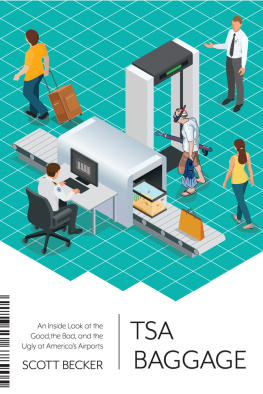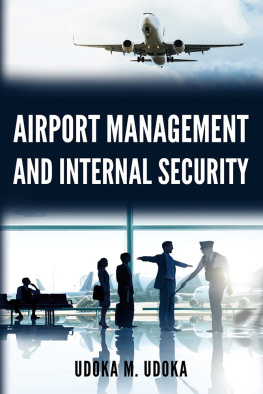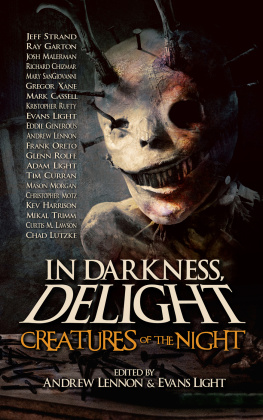The End of Airports
For Lara
The End of Airports
Christopher Schaberg
Bloomsbury Academic
An imprint of Bloomsbury Publishing Inc


Contents

THANKS to Mark Yakich, Ian Bogost, Greg Keeler, Pam Houston, Kara Thompson, Caren Kaplan, Nathan Henne, Hillary Eklund, Laura Murphy, Tim Welsh, Tim Morton, and Jeffrey Jerome Cohen for intellectual camaraderie and ongoing friendship as I worked on this book. Thanks to Catalina Ayubi for letting me use the haunting photograph on the cover of the book. Im grateful to my research assistant Erin Little, for her assistance assembling the bibliography and for helpful suggestions as I finished the manuscript.
Dean Maria Calzada, Melanie McKay and the Center for Faculty Innovation, John Biguenet, and the English department at Loyola provided key support for the completion of this book. A big thanks to my Loyola students in 2014 who took my Interpreting Airports seminars, who worked through these topics with me, and who provided me with insightful feedback and enthusiasm for the project: Victoria Cinnater, Stratton Day, Peter De Armas, Alana (extra credit) Demaske, Camille Didelot-Hearn, Mik Grantham, Julia Houha, Fionn Hunter-Green, Ana Colon Longo, Madeline Marva, Colin Mausler, Victoria Odom, Dave Thomas, Jack Vanchiere, Aaron Walker, Oliva Wells, Tom Whelan, Micaela Adamo, J. T. Barbour, Ernesto Caro, Frank Convit, Quynh-Nhu Dang, Emily Edwards, Adam El-Khazindar, Gabrielle Gatto, Madeline Horta, Kameron Lopreore, Kaleigh Macchio, Devon Malone, Leigh Maloney, Alex Samples, Adam Stelly, Cristina Suarez, Django Szilagi, Christiana Van Bree, Alex Ward, and Bryan Whittingtonthanks for being great students and generous readers.
Once again I am indebted to Haaris Naqvi at Bloomsbury for his constant guidance, support, and verve on the publishing end of things. Thanks to the three anonymous readers who provided me with astute reader reports, which greatly improved the book. Malcolm Harris and Erika Kerruish provided valuable editorial feedback on essays that helped sharpen my writing. Thanks to The Atlantic , The Millions , Narrative , The New Inquiry , The New York Times , and Transformations , for publishing earlier drafts of parts of this book. And thank you to Robert Appelbaum for inviting me to Uppsala, Sweden, to give a plenary talk on airports at the Nordic Association for English Studies 2013 conference Places & Non-places, where this book started to come together in my mind.
Thanks to my parents Susann and Jim Schaberg for all kinds of support, especially during the summer months. Finally, thanks to my familyLara, Julien, and Camillefor traveling with me, for filling our home with love and wonder, and for tolerating my predawn writing sprees.
Why do we still have airports? Why are they called airports?
DON DELILLO, COSMOPOLIS
As I write this, I am on a small regional jet, in seat 3D, flying over Lake Michigan en route to Minneapolis, where I will board another plane and fly to Bozeman, Montana. I am headed to Bozeman to visit the airport that I worked at over ten years ago. I worked there to supplement my income as a graduate student English instructor at Montana State University. At the time I wasnt thinking about the airport as a site of rich philosophical inquiry. I was just working there. Many years later, I started to recall the strange and routine parts of my airport work, and I realized I needed to get back, to see this space again.
What do I expect to find at this airport? Ostensibly I am returning to see how the small airport has changed over the past decade: how it has expanded, and how it has embraced (or not) the rise in digital technologies and the attendant pressures they put on air travel. In fact, though, I could discover most of these things by simply reading online about the airports new amenities, features, and developments; I could look at the airport via satellite imagery, as I have done from time to time, to see how it has grown physically since I worked therea new jet bridge here, a freshly paved parking lot there, new rooflines nearly matching the old ones.
But I am after something elsesomething more abstract, less concrete. Or maybe Im after something more concrete, something ingrained in the mundane fabric and materials of the airport. I want to experienceor reexperiencelife on the ground, at the airport.
I dont expect to find any of my old coworkers; my hunch is that they have all moved on, either to more illustrious airline careers (I heard a rumor that my former manager moved on to become an operations manager in Denver) or on to other jobs, other places, other livesor even death. Neither do I expect to find stunning architecture or mind-bending art installations. Airport art tends toward the bland and innocuousmost of the time, anyway. No, I am after something more ambient, something happenstance and easily overlooked. I am after the end of airports.
Looking back, it was at the Bozeman airport that I began to take note of the oddities that I would go on to research and write about in a book called The Textual Life of Airports: Reading the Culture of Flight (first published in 2011). That book was about airports in American literature and popular culture: I analyzed how airports appear in poems, novels, advertisements, films, songs... and I traced the patterns that these appearances made. I explored American airports in and as texts: how these spaces show up in American literature, and how the airports themselves become open to interpretation. I offered nine theories for how airports could be understood as narrative devices in American culture.
The book you are holding in your hands is different. It is less a study of airport representations. Its more personal, a story of my own encounters with airportsboth as actual places and as things to think about, as topics encountered in everyday life, such as in magazines and news feeds. It is thus a constrained book, idiosyncratic and verging on something close to autobiography at times. Yet this book is also expansive, and is about wide-reaching tensions, contradictions, and general feelings that haunt the experience of flight in the early twenty-first century.
As I was working on this book, people would inevitably ask me what I meant by the end of airports. The title of this book refers to the end of airports as romantic places; the end of airports as sites of excitement; the end of airports as apexes of travel culture. The end of airports means the end of our ability to appreciate airports, to inhabit them as dynamic, fascinating, forward-looking spaces.
Certainly some people still experience airports as exciting and romantic. But for the vast majority of travelers (not to mention airline employees), airports are grim, decidedly unromantic realmszones where we are subjected to screening, scrutiny, alienated labor, and inhumane treatment. It is this widespread, dispersed aura of gloom that, to me, portends the end of airports.
The end of airports also has to do with our everyday digital technologiesespecially the ones in our pocketsthat so radically outmode and outpace (even as they coexist with) the routines and rhythms of air travel. Simply consider the bumbling, at times chaotic, boarding procedures and departure operations that occur at an airport while at the same time passengers quietly use their smart phones to communicate and connect instantaneously at the delicate and precise taps of their thumbs. Its incredible to me that these two phenomena exist in the same historical moment: the slim lines of digital media, and the herding of bodies into airborne, dented metal tubes. Then again, iPhone screens crack, and thumbs get chewed. And a new plane is still something to see.
Next page








